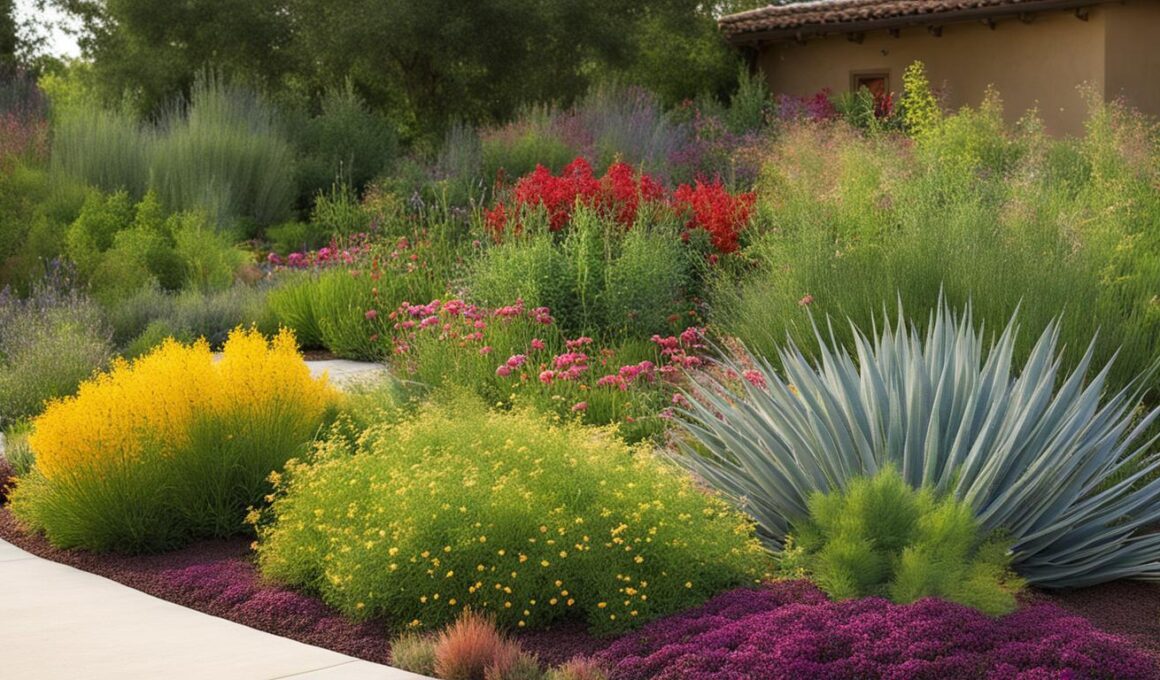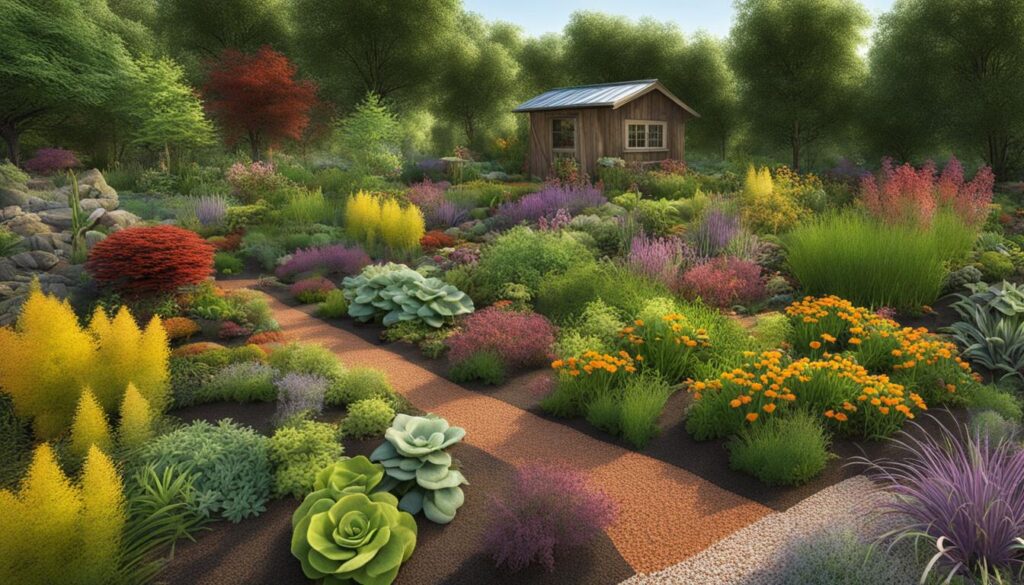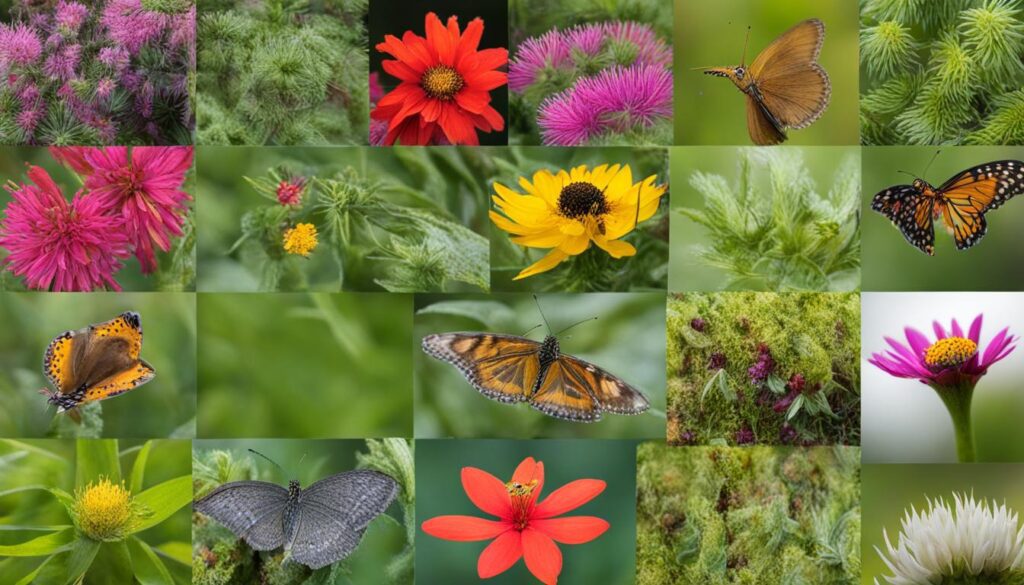Welcome to the world of sustainable landscaping! In this article, we will explore the fascinating combination of permaculture and xeriscaping techniques, and how they can work together to create beautiful and environmentally-friendly gardens. By harnessing the principles of permaculture, which mimic natural processes, and integrating water-conserving xeriscaping methods, you can transform your outdoor space into a thriving oasis while minimizing water usage.
Key Takeaways:
- Permaculture and xeriscaping can be combined to maximize the potential of your garden while conserving water.
- By reconnecting with nature and prioritizing sustainable practices, you can create a harmonious and environmentally-friendly landscape.
- Nature-based approaches, such as permaculture and xeriscaping, offer cost-effective solutions for mitigating climate change and preserving biodiversity.
- Developing a permaculture and xeriscaping landscape takes time and patience, but the result is a lush and vibrant space that benefits both wildlife and the gardener.
- As the landscape matures, signs of progress and ecological balance become evident, providing a visual delight and supporting local wildlife.
The Importance of Reconnecting with Nature
Many people have become disconnected from nature, prioritizing aesthetics over the natural environment. However, permaculture emphasizes the importance of observing and mimicking natural processes to benefit all. While aesthetics can play a role, it should never come at the expense of nature. By reconnecting with nature, individuals can create a harmonious and sustainable landscape.
Reconnecting with nature has numerous benefits. It allows us to appreciate the beauty and wonder of the natural world, fostering a sense of awe and inspiration. By immersing ourselves in nature, we can also experience the therapeutic and calming effects it provides, reducing stress and improving mental well-being.
Furthermore, reconnecting with nature enables us to develop a deeper understanding of our environment and the interconnections between all living things. By observing natural processes, such as the way plants grow and interact with each other, we can gain insights and apply these principles to our own landscapes.
Strategies for Reconnecting with Nature
- Spend time outdoors: Take frequent walks in nature, visit local parks, or go hiking in nearby trails. Disconnect from technology and immerse yourself in the sights, sounds, and smells of nature.
- Create a nature-friendly garden: Plant native species, provide habitats for wildlife such as bird feeders or bird baths, and incorporate natural elements like rocks and water features.
- Practice mindfulness: Engage in activities that promote mindfulness and presence, such as meditation, yoga, or simply sitting quietly and observing the natural world around you.
- Join nature conservation initiatives: Get involved in local environmental organizations or volunteer for community-based projects that aim to protect and restore natural habitats.
By making a conscious effort to reconnect with nature, we can foster a sense of responsibility and stewardship towards the environment. This not only benefits our own well-being but also contributes to the preservation of our planet for future generations.
Nature-Based Approaches for Sustainable Development
Nature-based solutions are gaining recognition as effective strategies for sustainable development. Incorporating principles from permaculture and xeriscaping, these approaches prioritize biodiversity protection and environmental conservation. By integrating nature conservation into development plans, municipalities, developers, and community groups can create resilient and sustainable landscapes.
Riparian management is one nature-based approach that can be employed to mitigate the impact of development on natural systems. By protecting and restoring the vegetation along water bodies, riparian zones can serve as buffers, filtering pollutants, reducing erosion, and providing habitat for wildlife. This not only improves water quality but also enhances the ecological functioning of the surrounding landscape.
Stormwater wetlands are another nature-based solution that can be utilized to manage development’s impact on natural systems. These wetlands act as natural filtration systems, capturing and treating stormwater runoff before it enters rivers and lakes. By mimicking the natural processes of wetland ecosystems, stormwater wetlands can help reduce the risk of flooding, improve water quality, and provide valuable habitat for a variety of plant and animal species.
Benefits of Nature-Based Approaches for Sustainable Development
- Promotes biodiversity conservation and habitat creation
- Enhances water quality and reduces the risk of flooding
- Improves air quality and reduces urban heat island effect
- Creates recreational spaces for communities
- Increases resilience to climate change
By embracing nature-based solutions like permaculture and xeriscaping, sustainable development can be achieved while minimizing environmental impacts. These approaches not only protect and enhance biodiversity but also provide multiple benefits for communities, such as improved air and water quality, increased recreational opportunities, and enhanced resilience to climate change. Incorporating nature into our development plans is a crucial step towards creating a more sustainable and harmonious future.
The Journey to a Lush, Vibrant Landscape
Creating a lush and vibrant landscape through a combined permaculture and xeriscaping approach is a journey that requires patience and careful planning. One of the key aspects of this journey is the growth of plantings. While it may take a few years for the plants to fill in and reach their full potential, the result is a landscape that is not only visually appealing but also promotes biodiversity.
During the development of your permaculture and xeriscaping landscape, it’s important to approach the planting process in stages. This allows you to observe how different species adapt to your site’s conditions and make informed choices for future plant selections. By focusing on a variety of flowers and grasses, you can create a haven for wildlife while also ensuring a sustainable source of food for yourself.
As your landscape matures, you’ll start to witness signs of progress and ecological balance. Older plants will experience growth spurts, showcasing an explosion of colors during the growing season. Leaf litter will accumulate on-site, providing a natural habitat for wildlife. Excess leaf litter can be added to a compost bin, promoting nutrient recycling. The evolving landscape will attract a diverse range of wildlife, including pollinators and birds, further enhancing the ecological balance.
Throughout the journey, the structure of your landscape will begin to take shape. Shrubs and trees will fill in, not only adding privacy but also creating valuable wildlife habitat. Strategic planting of wet-tolerant species in areas prone to water accumulation will help manage drainage issues. Downspout rain gardens will contribute to the overall water management system, reducing reliance on artificial methods such as sump pumps.
Key Points:
- The journey to a lush and vibrant landscape requires patience and careful planning.
- Plantings may take a few years to fill in, but the end result is a visually appealing landscape that promotes biodiversity.
- Plant in stages to observe how different species adapt to your site and make informed choices for future plant selections.
- A focus on a variety of flowers and grasses provides a sustainable source of food for yourself and a haven for wildlife.
- As the landscape matures, signs of progress and ecological balance become evident, such as growth spurts, vibrant colors, and the accumulation of leaf litter.
- The evolving landscape attracts diverse wildlife, including pollinators and birds.
- Shrubs and trees fill in, adding privacy and valuable wildlife habitat.
- Strategic planting in areas prone to water accumulation helps manage drainage issues.
- Downspout rain gardens contribute to overall water management.
Signs of Progress and Ecological Balance
As your permaculture and xeriscaping landscape matures, you will start to see signs of progress and the development of a more balanced ecosystem. The growth spurt of older plants becomes evident, bringing an explosion of colors during the growing season. This vibrant display not only adds aesthetic appeal to your landscape but also indicates the health and vitality of your plants.
One of the key benefits of a combined permaculture and xeriscaping approach is the creation of a wildlife habitat. As your garden evolves, it becomes a refuge for various species, including pollinators and birds. They find sustenance and shelter in the diverse plantings and interconnected ecological systems you have created. The presence of wildlife is a positive sign that your landscape is thriving and contributing to the local ecosystem.
Leaf litter plays an important role in maintaining the ecological balance of your landscape. As leaves naturally fall and accumulate on the ground, they act as a protective layer, regulating soil temperature and moisture levels. This layer serves as a food source and habitat for beneficial organisms, such as earthworms and insects, which contribute to the overall health of your soil. Additionally, excess leaf litter can be gathered and added to a compost bin for nutrient recycling, further enhancing the sustainability of your garden.
Key Points:
- The growth spurt of older plants brings an explosion of colors during the growing season.
- A permaculture and xeriscaping landscape provides a wildlife habitat, attracting pollinators and birds.
- Leaf litter regulates soil temperature and moisture levels, and serves as a food source and habitat for beneficial organisms.
- Excess leaf litter can be added to a compost bin for nutrient recycling.
How Can Permaculture Principles be Incorporated into Xeriscape Color Schemes?
When incorporating permaculture principles into xeriscape color schemes, it’s important to consider adaptive xeriscape color schemes that utilize native plants and sustainable design. By choosing drought-tolerant species and incorporating a variety of textures and colors, you can create a visually stunning landscape while conserving water and promoting biodiversity.
The Structure Takes Shape
As your permaculture and xeriscaping landscape continues to mature, a beautiful structure begins to emerge. The aerial view showcases the progress and transformation that has taken place. The once sparse and barren areas are now filled with lush vegetation and thriving ecosystems. It’s a testament to your dedication and the power of combining these two sustainable gardening approaches.
The growth of shrubs and trees plays a vital role in creating both privacy and habitat for wildlife. These plants provide shelter, food, and nesting sites, attracting a variety of birds and beneficial insects to your garden. The landscape comes alive with their presence and adds to the overall ecological balance you have worked so hard to achieve.
Drainage solutions also play a crucial role in the structure of your landscape. Properly designed downspout rain gardens help manage stormwater, reducing the reliance on sump pumps and minimizing the impact on municipal drainage systems. Additionally, strategic planting in areas prone to water accumulation ensures that your landscape remains functional and visually appealing.
In summary, as you continue to nurture your permaculture and xeriscaping garden, the structure of your landscape takes shape. The growth of shrubs and trees creates habitat for wildlife and adds privacy to your space. Drainage solutions ensure effective stormwater management, and strategic plantings enhance both functionality and aesthetics. Your efforts are rewarded with an ever-evolving, sustainable, and visually appealing outdoor space.
Conclusion
By combining the principles of permaculture and xeriscaping, you can create a sustainable landscape that promotes ecological balance. This holistic approach maximizes your garden’s potential while prioritizing nature-based solutions.
Permaculture, with its focus on mimicking natural processes, allows you to create a harmonious environment that benefits all living organisms. Xeriscaping, on the other hand, emphasizes water conservation, making your garden resilient in drought-prone regions.
With a combined permaculture and xeriscaping approach, you can achieve a lush and vibrant landscape while minimizing your environmental impact. By planting strategically and prioritizing biodiversity, you create a habitat for wildlife and contribute to a healthier ecosystem.
Embrace the power of permaculture and xeriscaping to transform your outdoor space into a sustainable oasis. By incorporating these approaches, you not only create a beautiful garden but also play a vital role in nurturing the environment and promoting ecological balance.














